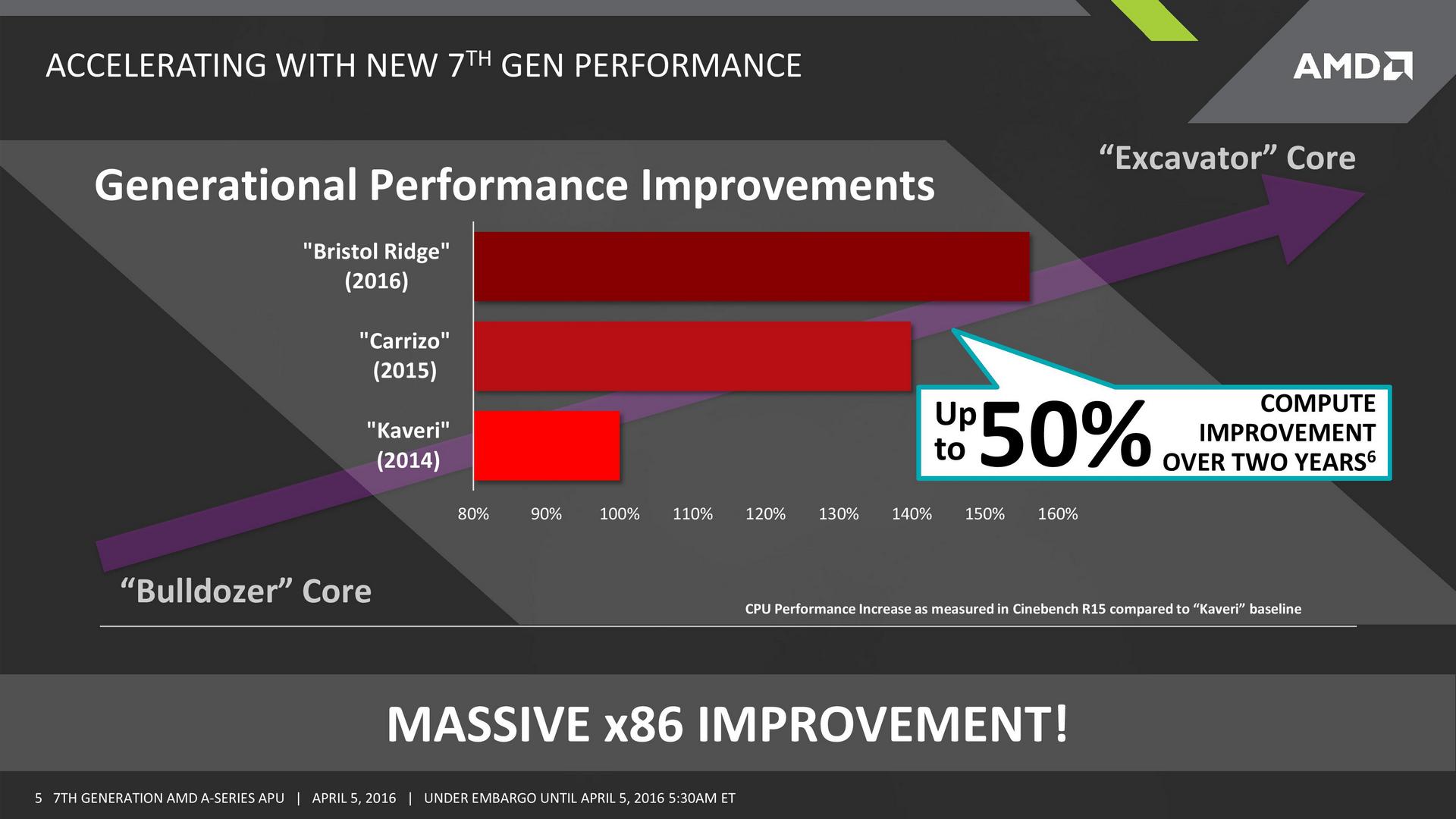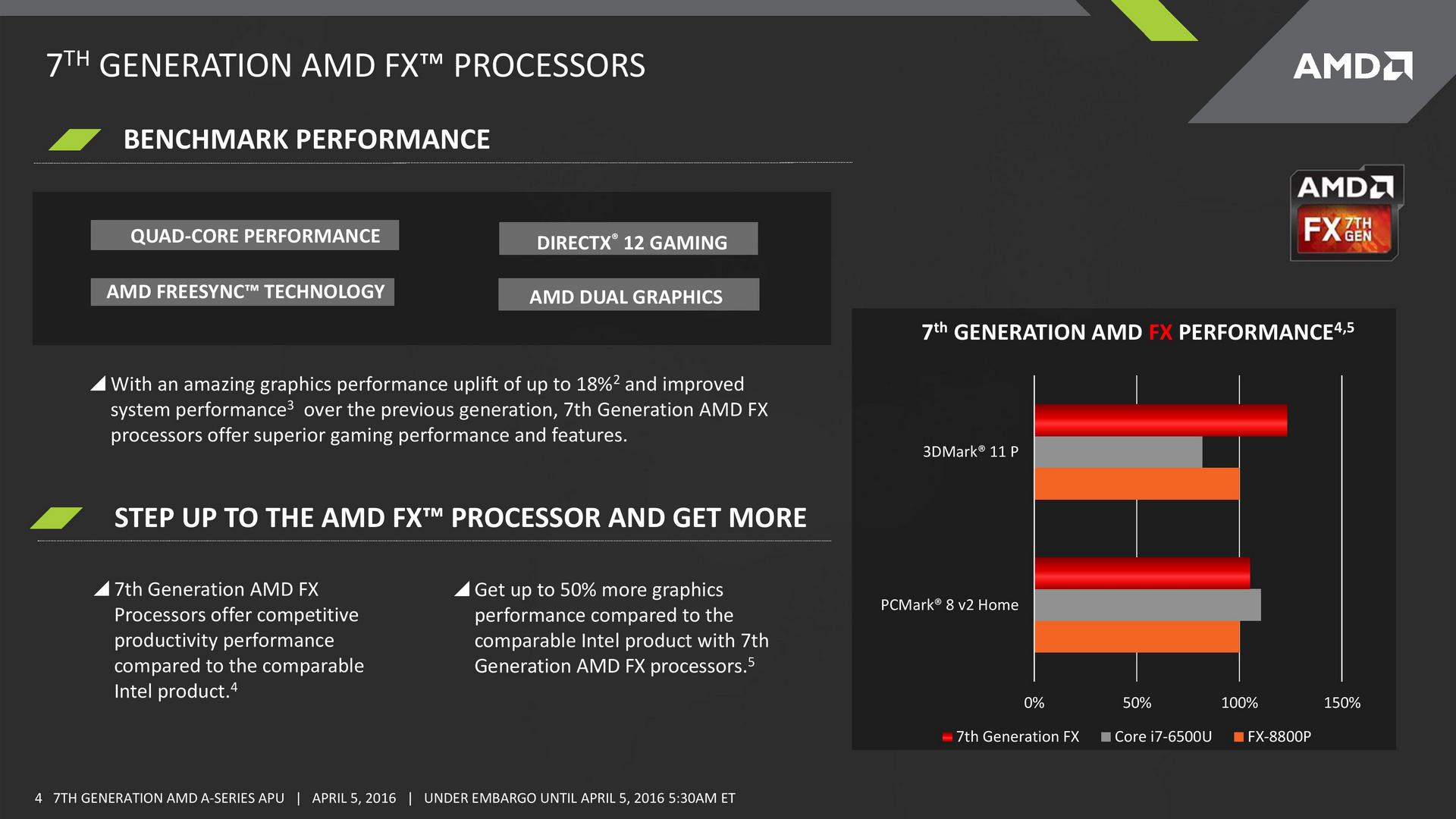AMD Pre-Announces Bristol Ridge in Notebooks: The 7th Generation APU
by Ian Cutress on April 5, 2016 6:30 AM EST-page-002_678x452.jpg)
For anyone tracking AMD’s family of Accelerated Processing Units (APUs), the last generation Carrizo was launched back in the middle of 2015. This was based on the fourth iteration of the Bulldozer module design (the cores are codenamed Excavator), focused entirely on notebooks at a 15-35W power window. Today marks the pre-announcement of the 2016 line, Bristol Ridge, for notebooks.
The main difference between Bristol Ridge and Carrizo is the implementation of a DDR4 memory controller, along with minor microarchitecture manufacturing tweaks. We’ve already seen Carrizo/Excavator under DDR4 in the embedded space, and AMD is claiming that this latest generation of Bristol Ridge offers up to at 50% CPU improvement over Kaveri, launched in 2014, and Bristol Ridge is some 10% over Carrizo due to the new memory support.
Despite AMD quoting a 50% gain in Cinebench compared to Kaveri, AMD’s strengths in the notebook line are partly due to the integrated graphics, which historically gets a boost from faster memory. Although this depends on the underlying design by the OEM, as we detailed in our Carrizo OEM overview that pointed the finger at base single channel memory designs being the norm at retail, rather than dual channel.
Today is a pre-announcement, which means that details are very thin. The reason this is not a full launch lies in one of AMD’s OEM partners, HP, announcing a new notebook at GTC this week based on AMD’s Bristol Ridge designs. HP is AMD’s biggest partner in notebooks, and is launching the HP Envy x360 15-inch variant using a Bristol Ridge part under the AMD FX naming scheme.
We’ll go deeper into the Envy x360 announcements in a separate news post. But this pre-announcement means that AMD are happy to talk about high level details such as 3DMark performance compared to Carrizo and Intel, FreeSync sypport, Dual Graphics, DirectX 12 and so on, but we will have to wait until Computex 2016 when we’ll get the full breakdown of the APU advancements, SKU names, clock speeds and where these APUs will be implemented.
As mentioned in previous news posts, AMD on the desktop has confirmed that Bristol Ridge and the upcoming Summit Ridge APUs featuring a brand new microarchitecture design will share a platform. We could extrapolate (as others have done so) to suggest that this notebook platform will also be the one supporting Summit Ridge on notebooks when it is released, however AMD has not officially confirmed this for this pre-announcement. We will have to wait for Computex for more details.
Further Reading:
AMD Launches Excavator APUs for Embedded with DDR4 Support
Who Controls the User Experience? AMD’s Carrizo Thoroughly Tested
AMD Launches Carrizo: The Laptop Leap of Efficiency and Architecture Updates





-page-001_thumb.jpg)
-page-002_thumb.jpg)
-page-003_thumb.jpg)
-page-007_thumb.jpg)
-page-008_thumb.jpg)
-page-009_thumb.jpg)








38 Comments
View All Comments
shadarlo - Tuesday, April 5, 2016 - link
Comparing a producer of the end-user products with a company that makes one component of a product that other manufacturers use....Fanboy is strong in this one.
Odo2016 - Tuesday, April 5, 2016 - link
This. "Despite AMD quoting a 50% gain in Cinebench compared to Kaveri, AMD’s strengths in the notebook line are partly due to the integrated graphics, which historically gets a boost from faster memory. Although this depends on the underlying design by the OEM, as we detailed in our Carrizo OEM overview that pointed the finger at base single channel memory designs being the norm at retail, rather than dual channel." Toshiba, HP, ASUS, Acer, and Lenovo, are you listening? STOP CONFIGURING AMD APU LAPTOPS WITH SLOW, SINGLE-CHANNEL, RAM! ALSO, STOP THROTTLING THE APUS TO GET BETTER BATTERY LIFE!Also, I hate when charts appear to show a four-fold increase in performance when looking at the lengths of the bars, but when you look at the numbers, it's really only 1/8th of that. So misleading.
As usual, the information was very good. I just wish manufacturers would pay attention to Anand's articles.
epobirs - Tuesday, April 5, 2016 - link
Just not going to happen. The AMD APUs are mainly used to target the low end, where price is everything. Shipping with a single channel populated is part of that. The real damage is from designs that have no provision for populating the second channel.azazel1024 - Tuesday, April 5, 2016 - link
Actually, if it is solely based on the graphs, Bristol is only 7% "better" or faster or whatever than Carrizo. 10% better it is not. It is supposedly up to 50% better than Kaveri and Carrizo is up to 140% better than Kaveri. 1.5/1.4 = 1.07. 7% faster or better or whatever.Which, granted, is as much as an Intel generation these days. But still marketing speak to try to make it seem even better. The other question is, how much of that is a gain because of DDR4? I assume that is factored in to that 7% gain.
nandnandnand - Tuesday, April 5, 2016 - link
Actually the Bristol Ridge bar looks closer to 1.55. 1.55/1.4 = 1.107.ET - Wednesday, April 6, 2016 - link
The actual value from the press release is +56.09%. The Carrizo score isn't mentioned there though (but the image does look like +40%). That said, it's all for the 15W scenario. Not that another 10% at 15W is bad.webdoctors - Tuesday, April 5, 2016 - link
I was gonna make a joke about where can you actually buy a decent AMD Laptop, but it looks like Amazon sells some:http://www.amazon.com/Lenovo-15-6-inch-Performance...
Not clear if the 1 hr battery life in the reviews are true.
vortmax2 - Tuesday, April 5, 2016 - link
That one is not dual-channel according to reviewers.Shadowmaster625 - Tuesday, April 5, 2016 - link
They need to force OEMs to use both memory channels... or else those cheapskates wont.epobirs - Tuesday, April 5, 2016 - link
How do you propose they do that? AMD is desperate for business and could not survive dictating design to customers they know full well are looking to fill the low end of their product line.